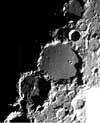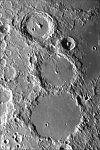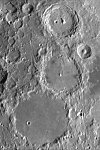
 Robin Casady's CCD images of Ptolemaeus (left) and Arzachel (right).
Robin Casady's CCD images of Ptolemaeus (left) and Arzachel (right).

 Thierry Legault's
CCD images of Ptolemaeus (bottom), Alphonsus (center) and Arzachel (top)
at first quarter (left) and at last quarter(right).
Thierry Legault's
CCD images of Ptolemaeus (bottom), Alphonsus (center) and Arzachel (top)
at first quarter (left) and at last quarter(right).

 Robin Casady's CCD images of Ptolemaeus (left) and Arzachel (right).
Robin Casady's CCD images of Ptolemaeus (left) and Arzachel (right).
See also an impressive high-resolution shot of the area at astro-shop.com,
![[ Ptolemaeus at sunrise, by David North ]](../images/sketch/dave-ptolemaeusT.jpg)
Things can't be dimly lit on the moon...
For more detail and sketches, see the discussion on timocharis.com.
Mark Taylor: I was thinking about a jaggedy surface lit just at the tips of the jaggies, so you see a (laser-printer-style) gray scale illumination.
David: The more I think about it, the more I like this. Combined with the arc of the bottom of the crater ... it lights from the center out, in obviuos rays (at least on nights like this) and other craters don't appear to.
But considering your suggesting, I'd guess that's the "root methodology" here, though I don't recall seeing anything similar in any of the other big plains.
Weird crater.
| Moon-Lite Atlas for chart 44 |